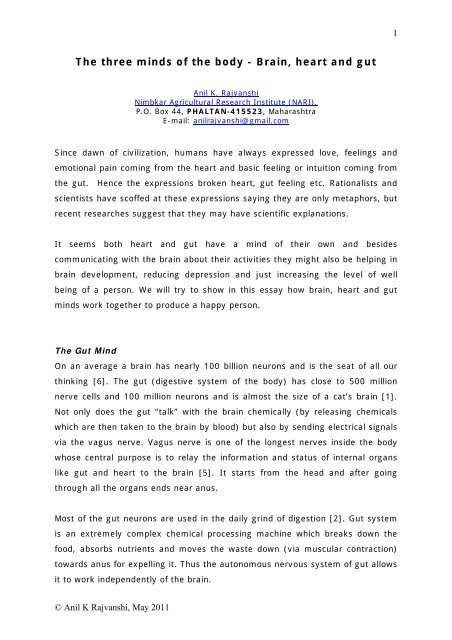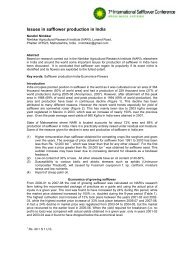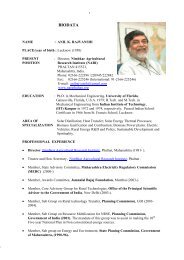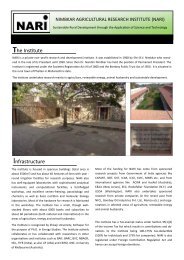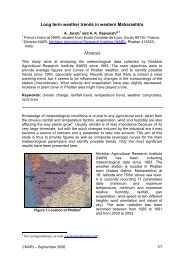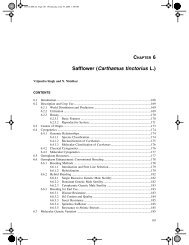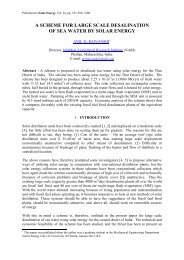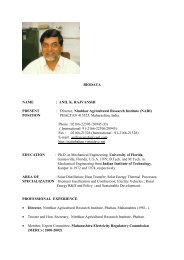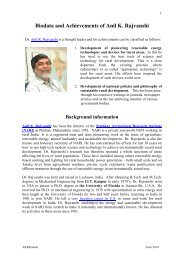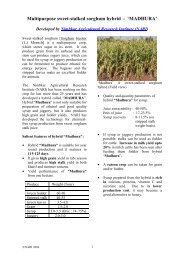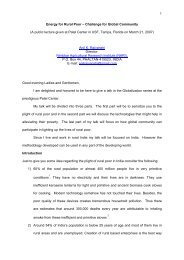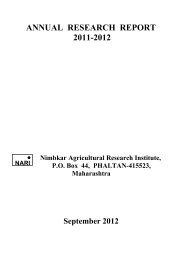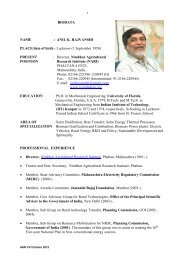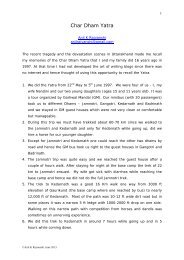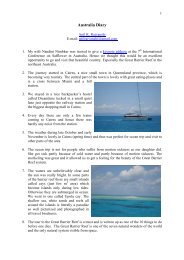The three minds of body - Brain, heart and gut - NARI
The three minds of body - Brain, heart and gut - NARI
The three minds of body - Brain, heart and gut - NARI
Create successful ePaper yourself
Turn your PDF publications into a flip-book with our unique Google optimized e-Paper software.
1<br />
<strong>The</strong> <strong>three</strong> <strong>minds</strong> <strong>of</strong> the <strong>body</strong> - <strong>Brain</strong>, <strong>heart</strong> <strong>and</strong> <strong>gut</strong><br />
Anil K. Rajvanshi<br />
Nimbkar Agricultural Research Institute (<strong>NARI</strong>),<br />
P.O. Box 44, PHALTAN-415523, Maharashtra<br />
E-mail: anilrajvanshi@gmail.com<br />
Since dawn <strong>of</strong> civilization, humans have always expressed love, feelings <strong>and</strong><br />
emotional pain coming from the <strong>heart</strong> <strong>and</strong> basic feeling or intuition coming from<br />
the <strong>gut</strong>. Hence the expressions broken <strong>heart</strong>, <strong>gut</strong> feeling etc. Rationalists <strong>and</strong><br />
scientists have sc<strong>of</strong>fed at these expressions saying they are only metaphors, but<br />
recent researches suggest that they may have scientific explanations.<br />
It seems both <strong>heart</strong> <strong>and</strong> <strong>gut</strong> have a mind <strong>of</strong> their own <strong>and</strong> besides<br />
communicating with the brain about their activities they might also be helping in<br />
brain development, reducing depression <strong>and</strong> just increasing the level <strong>of</strong> well<br />
being <strong>of</strong> a person. We will try to show in this essay how brain, <strong>heart</strong> <strong>and</strong> <strong>gut</strong><br />
<strong>minds</strong> work together to produce a happy person.<br />
<strong>The</strong> Gut Mind<br />
On an average a brain has nearly 100 billion neurons <strong>and</strong> is the seat <strong>of</strong> all our<br />
thinking [6]. <strong>The</strong> <strong>gut</strong> (digestive system <strong>of</strong> the <strong>body</strong>) has close to 500 million<br />
nerve cells <strong>and</strong> 100 million neurons <strong>and</strong> is almost the size <strong>of</strong> a cat’s brain [1].<br />
Not only does the <strong>gut</strong> “talk” with the brain chemically (by releasing chemicals<br />
which are then taken to the brain by blood) but also by sending electrical signals<br />
via the vagus nerve. Vagus nerve is one <strong>of</strong> the longest nerves inside the <strong>body</strong><br />
whose central purpose is to relay the information <strong>and</strong> status <strong>of</strong> internal organs<br />
like <strong>gut</strong> <strong>and</strong> <strong>heart</strong> to the brain [5]. It starts from the head <strong>and</strong> after going<br />
through all the organs ends near anus.<br />
Most <strong>of</strong> the <strong>gut</strong> neurons are used in the daily grind <strong>of</strong> digestion [2]. Gut system<br />
is an extremely complex chemical processing machine which breaks down the<br />
food, absorbs nutrients <strong>and</strong> moves the waste down (via muscular contraction)<br />
towards anus for expelling it. Thus the autonomous nervous system <strong>of</strong> <strong>gut</strong> allows<br />
it to work independently <strong>of</strong> the brain.<br />
© Anil K Rajvanshi, May 2011
2<br />
Nevertheless recent researches have revealed that there is a tremendous<br />
amount <strong>of</strong> information flow from the <strong>gut</strong> to the brain via the vagus nerve <strong>and</strong><br />
this flow is mostly one sided – almost all <strong>of</strong> it is from the <strong>gut</strong> to the brain <strong>and</strong><br />
not the other way around [2]. This is how it should be since <strong>gut</strong> works<br />
continuously whether we are aware <strong>of</strong> it or not.<br />
<strong>The</strong> reverse interaction (from the brain to the <strong>gut</strong>) is when we get hunger pangs<br />
<strong>and</strong> the brain tells the <strong>body</strong> to get food or when something goes wrong in the<br />
<strong>gut</strong> like pain or diarrhea, necessitating medicines for its cure. Sometimes these<br />
signals go haywire. For example even if there are hunger pangs the brain<br />
overrules the <strong>gut</strong> <strong>and</strong> this leads to Anorexia!<br />
Recent scientific evidence also suggests that a big part <strong>of</strong> our emotions are<br />
probably influenced by the chemicals <strong>and</strong> nerves in the <strong>gut</strong>. For example 95%<br />
<strong>of</strong> <strong>body</strong>’s Serotonin is found in the <strong>gut</strong> [2]. Serotonin is an important<br />
neurotransmitter which is a well known contributor towards feelings <strong>of</strong> well<br />
being. Sometimes it is also called a “happiness hormone”. Similarly researches<br />
have found that a bacteria-free <strong>gut</strong> in early childhood leads to adults with less<br />
anxiety <strong>and</strong> general cheerfulness. Interestingly the effect <strong>of</strong> early childhood <strong>gut</strong><br />
bacteria has the maximum impact on the developing brain <strong>and</strong> peters <strong>of</strong>f by the<br />
age <strong>of</strong> 2-3 years just when the brain expansion also starts slowing down.<br />
Apparently the ancients knew something about the <strong>gut</strong>-brain connection. Hence<br />
the colon cleaning process <strong>of</strong> Ayurveda (including enema etc.) or “<strong>gut</strong><br />
wrenching” exercises <strong>of</strong> Nauli in Hath Yoga help in cleaning the <strong>gut</strong> thereby<br />
increasing the feeling <strong>of</strong> wellness. Similarly the yogic exercise <strong>of</strong> Mayur Asana,<br />
where the <strong>body</strong> is balanced on the navel <strong>and</strong> this pressure on it stimulates the<br />
vagus nerve, helps improve the brain-<strong>gut</strong> connection.<br />
<strong>The</strong>re are also many instances <strong>of</strong> people experiencing extrasensory perception<br />
(ESP) or clairvoyance after colon cleansing has taken place. One <strong>of</strong> the reasons<br />
for this could be that a clean <strong>gut</strong> frees its neurons to help the brain increase its<br />
processing power. This extra neural power may help the brain process more<br />
information <strong>and</strong> help it in Samadhi or Sanyam. In nature every process has<br />
© Anil K Rajvanshi, May 2011
3<br />
multiple uses. Though the <strong>gut</strong> neurons are used most <strong>of</strong> the time for <strong>gut</strong> activity,<br />
they also interact with the brain via the vagus nerve.<br />
In Patanjali Yoga <strong>gut</strong> occupies the center <strong>of</strong> <strong>body</strong>-universe! It says that by<br />
Sanyam on navel (Nabhi, <strong>gut</strong> etc.), a yogi gains the knowledge <strong>of</strong> the<br />
constituents <strong>of</strong> the <strong>body</strong>!<br />
<strong>The</strong> Heart Mind<br />
Heart is one <strong>of</strong> the most important organs <strong>of</strong> the human <strong>body</strong>. Life starts when it<br />
starts beating (21 days after conception) <strong>and</strong> ends (clinical death) when it stops.<br />
Heart has nearly 2 billion muscle cells <strong>and</strong> 40,000 neurons. <strong>The</strong> <strong>heart</strong> neurons<br />
are very few in number compared to those in the brain (100 billion) or <strong>gut</strong> (0.1<br />
billion). Nevertheless these neurons transmit <strong>heart</strong>’s signals <strong>and</strong> its condition to<br />
the brain.<br />
<strong>The</strong> <strong>heart</strong>-mind interaction takes place both by electrical signals (via the vagus<br />
<strong>and</strong> the spinal chord nerves) <strong>and</strong> through chemicals (<strong>heart</strong> is an endocrine gl<strong>and</strong><br />
also).<br />
Recent studies have shown that <strong>heart</strong> sends signals to the brain that are not<br />
only understood by it but also obeyed. Scientists have discovered neural<br />
pathways <strong>and</strong> mechanisms whereby input from <strong>heart</strong> to brain inhibits or<br />
facilitates brain’s electrical activity – just like what <strong>gut</strong> is capable <strong>of</strong> doing. Thus<br />
both <strong>gut</strong> <strong>and</strong> <strong>heart</strong> mind help in overall thought process.<br />
Besides the electrical signaling, <strong>heart</strong> is also an endocrine gl<strong>and</strong> releasing<br />
peptides which help in blood pressure modulation <strong>and</strong> improving the functioning<br />
<strong>of</strong> kidneys [3]. <strong>The</strong>se peptides also stimulate the pituitary gl<strong>and</strong> thereby helping<br />
it to release hormones like oxytocin commonly referred to as “love” or bonding<br />
hormone. Oxytocin also helps in increasing the well being <strong>of</strong> a person. This could<br />
be the basis <strong>of</strong> saying that happy feelings emanate from the <strong>heart</strong>!<br />
Nevertheless the point <strong>of</strong> interest is the rhythm patterns <strong>of</strong> the <strong>heart</strong> which<br />
result when two billion muscle cells are triggered by AV <strong>and</strong> SA nodes which are<br />
© Anil K Rajvanshi, May 2011
4<br />
like electrical switches. <strong>The</strong>se nodes which are inside the <strong>heart</strong> send electrical<br />
signals to the <strong>heart</strong> muscles for contraction <strong>and</strong> are one <strong>of</strong> the most important<br />
organs <strong>of</strong> the <strong>heart</strong>. When they do not function properly the electrical signals to<br />
the muscles go haywire <strong>and</strong> the <strong>heart</strong> starts to flutter. A pacemaker attached to<br />
these nodes streamlines the signals <strong>and</strong> can restore the proper working <strong>of</strong> the<br />
<strong>heart</strong>.<br />
<strong>The</strong> speed <strong>of</strong> <strong>heart</strong>beat or its contraction changes depending upon our emotions.<br />
For example when we are aroused either by passion or anger then the <strong>heart</strong><br />
speeds up <strong>and</strong> in more quiet times or in meditation it slows down. This electrical<br />
input to the AV <strong>and</strong> SA nodes from the brain comes via the vagus nerve <strong>and</strong> is<br />
reflected in the ECG patterns <strong>of</strong> the <strong>heart</strong>.<br />
Pranayama or breathing exercises can stimulate the vagus nerve <strong>and</strong> this could<br />
have a very beneficial effect both on the <strong>heart</strong> <strong>and</strong> <strong>gut</strong>. Similarly the chanting <strong>of</strong><br />
mantras or deep throat singing as practised by Buddhist Lamas also stimulates<br />
the vagus nerve. It has been show that this stimulation helps in reducing blood<br />
pressure <strong>and</strong> improves the rhythm patterns <strong>of</strong> the <strong>heart</strong>. <strong>The</strong> neural information<br />
from both these activities facilitates the cortical function <strong>and</strong> the effect is<br />
heightened mental clarity, improved decision making <strong>and</strong> increased creativity.<br />
Similarly the stimulation <strong>of</strong> the vagus nerve helps the <strong>gut</strong> to perform better <strong>and</strong><br />
improves the cleaning process <strong>of</strong> the colon. For example the ancient Indian<br />
custom <strong>of</strong> applying pressure on cheeks by fists while sitting on toilet seat helps<br />
in the bowel movement. <strong>The</strong> pressure on cheeks stimulates the vagus nerve<br />
since its branches pass through the face. This could also be the basis <strong>of</strong><br />
children’s cheek pinching by adults!<br />
Recently scientists have also discovered that <strong>heart</strong> is involved in the processing<br />
<strong>and</strong> decoding <strong>of</strong> “intuitive information” [4]. Tests done on the subjects showed<br />
that the <strong>heart</strong> appeared to receive the intuitive information before the brain.<br />
This could be the basis <strong>of</strong> saying “Follow you <strong>heart</strong> <strong>and</strong> you will never go wrong”.<br />
© Anil K Rajvanshi, May 2011
5<br />
This brain/<strong>heart</strong> interaction was also known to the ancients. In Patanjali yoga it<br />
is written that by Sanyam on the <strong>heart</strong> a yogi acquires the complete knowledge<br />
<strong>and</strong> contents <strong>of</strong> his mind.<br />
Thus in order to produce deep thought which helps in improving the well being<br />
<strong>of</strong> a person [6], it is necessary that the <strong>gut</strong> <strong>and</strong> <strong>heart</strong> brains work together with<br />
the main brain. When all <strong>of</strong> them work together harmoniously then it creates a<br />
healthy <strong>body</strong> <strong>and</strong> a powerful mind.<br />
REFERENCES<br />
1. Robert Mastone. “<strong>The</strong> Neuroscience <strong>of</strong> the Gut”. Scientific American, April<br />
19, 2011.<br />
2. Adam Hadhazy. “Think Twice : How the Gut’s “Second <strong>Brain</strong>” Influences<br />
Mood <strong>and</strong> Well Being”. Scientific American, February 12, 2010.<br />
3. M. Cartin <strong>and</strong> J. Genest. “<strong>The</strong> Heart as an Endocrine Gl<strong>and</strong>”, Scientific<br />
American, February 1986, Vol. 254, No. 2, pg 62-67.<br />
4. McCraty R., et al. “Electrophysiological Evidence <strong>of</strong> Intuition : Part 1. <strong>The</strong><br />
Surprising role <strong>of</strong> Heart”. J. <strong>of</strong> Alternative <strong>and</strong> Complementary Medicine, 10<br />
(1) : pg 133-143, 2004.<br />
5. Vagus Nerve. http://en.wikipedia.org/wiki/vagus_nerve.<br />
6. Anil K. Rajvanshi, Nature <strong>of</strong> Human Thought (Second Ed.). Published by<br />
<strong>NARI</strong>. 2010.<br />
Published as an article in Speaking Tree (Times <strong>of</strong> India), 29 May 2011.<br />
HOME<br />
© Anil K Rajvanshi, May 2011.<br />
© Anil K Rajvanshi, May 2011


